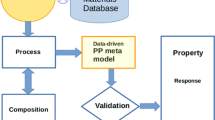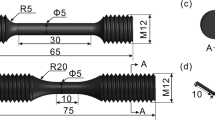Abstract
It is not completely understood fatigue strength at this time due to its complex formation mechanism. Therefore, in order to address this issue, machine learning has been used to examine the important factors involved in predicting fatigue strength. In this study, a hybrid model was proposed based on the modified bagging method by combining XGBoost and LightGBM, in which the hyperparameters of the models were optimized by a grey wolf algorithm. Moreover, an interpretable method, referred to as Shapley additive explanations (SHAP), was introduced to explain the fatigue strength predictions made by ML models. The SHAP values were calculated, and feature importance of fatigue strength by XGBoost, LightGBM and the hybrid model was discussed. The final results demonstrated that the SHAP method had major potential for interpreting fatigue strength predictions, which would provide constructive guidance for the development of antifatigue steel material in the future.












Similar content being viewed by others
References
Jose R, Ramakrishna S (2018) Materials 4.0: materials big data enabled materials discovery. Appl Mater Today 10:127–132. https://doi.org/10.1016/j.apmt.2017.12.015
Agrawal A, Choudhary A (2018) An online tool for predicting fatigue strength of steel alloys based on ensemble data mining. Int J Fatigue 113:389–400. https://doi.org/10.1016/j.ijfatigue.2018.04.017
Seshadri R, Sparks TD (2016) Perspective: interactive material property databases through aggregation of literature data. APL Mater 4:053206. https://doi.org/10.1063/1.4944682
Sukumar N, Krein M, Luo Q, Breneman C (2012) MQSPR modeling in materials informatics: a way to shorten design cycles? J Mater Sci 47:7703–7715. https://doi.org/10.1007/s10853-012-6639-0
Pilania G, Liu XY (2018) Machine learning properties of binary wurtzite superlattices. J Mater Sci 53:6652–6664. https://doi.org/10.1007/s10853-018-1987-z
Sun YT, Bai HY, Li MZ, Wang WH (2017) Machine learning approach for prediction and understanding of glass-forming ability. J Phys Chem Lett 8:3434–3439. https://doi.org/10.1021/acs.jpclett.7b01046
Feng S, Zhou H, Dong H (2019) Using deep neural network with small dataset to predict material defects. Mater Des 162:300–310. https://doi.org/10.1016/j.matdes.2018.11.060
Ward L, Agrawal A, Choudhary A, Wolverton C (2016) A general-purpose machine learning framework for predicting properties of inorganic materials. Npj Comput Mater 2:1–7. https://doi.org/10.1038/npjcompumats.2016.28
Sendek AD, Cubuk ED, Antoniuk ER, Cheon G, Cui Y, Reed EJ (2018) Machine learning-assisted discovery of solid li-ion conducting materials. Chem Mater 31:342–352. https://doi.org/10.1021/acs.chemmater.8b03272
Sokolov AN, Atahan-Evrenk S, Mondal R, Akkerman HB, Sánchez-Carrera RS, Granados-Focil S et al (2011) From computational discovery to experimental characterization of a high hole mobility organic crystal. Nat Commun 2:1–8. https://doi.org/10.1038/ncomms1451
Hachmann J, Olivares-Amaya R, Jinich A, Appleton AL, Blood-Forsythe MA, Seress LR et al (2014) Lead candidates for high-performance organic photovoltaics from high-throughput quantum chemistry-the Harvard clean energy project. Energy Environ Sci 7:698–704. https://doi.org/10.1039/c3ee42756k
Gomez IJ, Arnaiz B, Cacioppo M, Arcudi F, Prato M (2018) Nitrogen-doped Carbon Nanodots for bioimaging and delivery of paclitaxel. J Mater Chem B 6:5540–5548. https://doi.org/10.1039/x0xx00000x
Hautier G, Fischer CC, Jain A, Mueller T, Ceder G (2010) Finding natures missing ternary oxide compounds using machine learning and density functional theory. Chem Mater 22:3762–3767. https://doi.org/10.1021/cm100795d
Kreethi R, Sivateja C, Mondal AK, Dutta K (2019) Ratcheting life prediction of quenched–tempered 42CrMo4 steel. J Mater Sci 54:11703–11712. https://doi.org/10.1007/s10853-019-03705-3
Nikitin I, Fedoseeva A, Kaibyshev R (2020) Strengthening mechanisms of creep-resistant 12%Cr–3%Co steel with low N and high B contents. J Mater Sci 55:7530–7545. https://doi.org/10.1007/s10853-020-04508-7
Ye XW, Su YH, Han JP (2014) A state-of-the-art review on fatigue life assessment of steel bridges. Math Probl Eng 2014:1–13. https://doi.org/10.1155/2014/956473
Chen X, Sun Y, Wu Z, Yao L, Zhang Y, Zhou S et al (2019) An investigation on residual strength and failure probability prediction for plain weave composite under random fatigue loading. Int J Fatigue 120:267–282. https://doi.org/10.1016/j.ijfatigue.2018.10.013
Wang Y, Chai P, Ma H, Cao X, Zhang Y (2020) Formation mechanism and fracture behavior in extra-filling refill friction stir spot weld for Al–Cu–Mg aluminum alloy. J Mater Sci 55:358–374. https://doi.org/10.1007/s10853-019-03940-8
Furuya Y, Hirukawa H, Takeuchi E (2019) Gigacycle fatigue in high strength steels. Sci Technol Adv Mater 20:643–656. https://doi.org/10.1080/14686996.2019.1610904
Liu T, Zhu X, Chen L, Bi H, Lin Y, Long J (2020) Fatigue–creep behavior of two ferritic stainless steels in simulated automotive exhaust gas and argon. J Mater Sci 55:3684–3699. https://doi.org/10.1007/s10853-019-04233-w
Zhang M, Sun CN, Zhang X, Goh PC, Wei J, Hardacre D et al (2019) High cycle fatigue life prediction of laser additive manufactured stainless steel: a machine learning approach. Int J Fatigue 128:105194. https://doi.org/10.1016/j.ijfatigue.2019.105194
Wan HY, Chen GF, Li CP, Qi XB, Zhang GP (2019) Data-driven evaluation of fatigue performance of additive manufactured parts using miniature specimens. J Mater Sci Technol 35:1137–1146. https://doi.org/10.1016/j.jmst.2018.12.011
Kobayashi S (2019) Low-angle boundary engineering for improving high- cycle fatigue property of 430 ferritic stainless steel. J Mater Sci 55:1–13. https://doi.org/10.1007/s10853-020-04555-0
Rathi S (2019) Generating counterfactual and contrastive explanations using SHAP. arXiv:1906.09293
Mirjalili S, Mirjalili SM, Lewis A (2014) Grey wolf optimizer. Adv Eng Softw 69:46–61. https://doi.org/10.1016/j.advengsoft.2013.12.007
Chen T, Guestrin C. XGBoost: A scalable tree boosting system. In: Proc ACM SIGKDD Int Conf Knowl Discov Data Min 2016:785–94. https://doi.org/10.1145/2939672.2939785
Ke G, Meng Q, Finley T, Wang T, Chen W, Ma W et al (2017) LightGBM: a highly efficient gradient boosting decision tree. Adv Neural Inf Process. Syst. 2017:3147–3155
Zapotecas-Martínez S, García-Nájera A, López-Jaimes A (2019) Multi-objective grey wolf optimizer based on decomposition. Expert Syst Appl 120:357–371. https://doi.org/10.1016/j.eswa.2018.12.003
Holland JH (1992) Genetic algorithms. Sci Am 267:66–72. https://doi.org/10.1038/scientificamerican0792-66
Tian D, Shi Z (2018) MPSO: modified particle swarm optimization and its applications. Swarm Evol Comput 41:49–68. https://doi.org/10.1016/j.swevo.2018.01.011
Wu Y, Ma W, Miao Q, Wang S (2019) Multimodal continuous ant colony optimization for multisensor remote sensing image registration with local search. Swarm Evol Comput 47:89–95. https://doi.org/10.1016/j.swevo.2017.07.004
Choong SS, Wong LP, Lim CP (2019) An artificial bee colony algorithm with a modified choice function for the traveling salesman problem. Swarm Evol Comput 44:622–635. https://doi.org/10.1016/j.swevo.2018.08.004
Breiman LP (1996) Bagging Predictors. Mach Learn 24:123–140. https://doi.org/10.1007/BF00058655
Choi DK (2019) Data-driven materials modeling with XGBoost algorithm and statistical inference analysis for prediction of fatigue strength of steels. Int J Precis Eng Manuf 20:129–138. https://doi.org/10.1007/s12541-019-00048-6
Fan J, Wu L, Zhang F, Cai H, Ma X, Bai H (2019) Evaluation and development of empirical models for estimating daily and monthly mean daily diffuse horizontal solar radiation for different climatic regions of China. Renew Sustain Energy Rev 105:168–186. https://doi.org/10.1016/j.rser.2019.01.040
Papadopoulos S, Kontokosta CE (2019) Grading buildings on energy performance using city benchmarking data. Appl Energy 233:244–253. https://doi.org/10.1016/j.apenergy.2018.10.053
Lundberg SM, Erion GG, Lee S-I (2018) Consistent individualized feature attribution for tree ensembles. arXiv:1802.03888
Lundberg SM, Lee SI (2017) A unified approach to interpreting model predictions. In: Adv. Neural Inf. Process. Syst., 2017, pp. 4766–75
Lim S, Chi S (2019) Xgboost application on bridge management systems for proactive damage estimation. Adv Eng Inform 41:100922. https://doi.org/10.1016/j.aei.2019.100922
Acknowledgements
This work was supported by the project of the National Key R&D Program “Joint Research on Advanced Technology and Application of Electric Vehicles based on China-US Cooperation” (2016YFE0102200). It was also supported by the National Natural Science Foundation of China (grant number U1864207). The authors also sincerely gave thanks to the support of Technology Innovation and Entrepreneurship Team of Hunan Province
Author information
Authors and Affiliations
Contributions
FY was involved in methodology, writing—original draft preparation, and software. KS contributed to data curation, conceptualization, and formal analysis. YL helped in visualization and investigation. SC was involved in writing—reviewing and editing, supervision, and validation. JC contributed to resources, project administration, and funding acquisition.
Corresponding author
Ethics declarations
Conflict of interest
The authors declare that they have no known competing financial interests or personal relationships that could have appeared to influence the work reported in this paper.
Additional information
Publisher's Note
Springer Nature remains neutral with regard to jurisdictional claims in published maps and institutional affiliations.
Rights and permissions
About this article
Cite this article
Yan, F., Song, K., Liu, Y. et al. Predictions and mechanism analyses of the fatigue strength of steel based on machine learning. J Mater Sci 55, 15334–15349 (2020). https://doi.org/10.1007/s10853-020-05091-7
Received:
Accepted:
Published:
Issue Date:
DOI: https://doi.org/10.1007/s10853-020-05091-7




